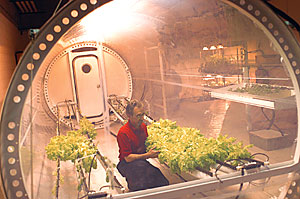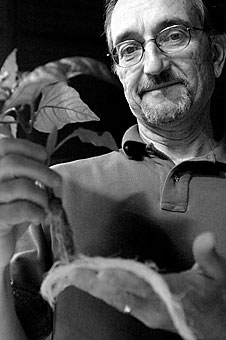 |
|
DJAMILA NOELLE GROSSMAN/ Arizona Daily Wildcat
|
Director of the controlled environment agriculture program Gene Giacomelli inspects lettuce in a growth chamber similar to those planned for use on a manned mission to Mars. Giacomelli also played a major role in building the growth chamber that now provides lettuce for people at the South Pole.
|
|
|
By Djamila Noelle Grossman
Arizona Daily Wildcat
Tuesday, April 12, 2005
Print this
South Pole inhabitants can now indulge on self-grown, fresh veggies, instead of living off canned and frozen cuisine.
Gene Giacomelli, director of the controlled environment agriculture program, built a growth chamber that is currently producing lettuce and other goodies at the South Pole. He also works on another chamber that is planned to go to Mars or the moon in a NASA spacecraft, he said.
How does it work?
In extreme environments, such as those of the South Pole or Mars, plants can be grown in controlled rooms without windows, using artificial light sources, Giacomelli said.
"We believe that we can grow any crop anywhere, anytime," he said. "What I don't add on there is at what cost."
But despite the high costs of such a project, researchers at the South Pole were in demand for fresh vegetables because it is impossible to maintain any supply traffic to and from the pole during the long winters, Giacomelli said.
As a result, the National Science Foundation, which supervises research at the South Pole, sent out floor plans and wanted people to bid on a green chamber that would fit their needs.
"I guess we were low bidders, we got it. And that's pretty rare for a university," Giacomelli said.
The chamber was built at the UA in the summer of 2003, using NSF requirements of size and electrical power, Giacomelli said. It was then tested and the NSF shipped the chamber to the South Pole.
Phil Saddler, owner of Saddler Machine Company in Tempe, lived and worked at the pole in previous years, Giacomelli said, and was the primary designer and builder of the green chamber.
Makin' it grow
The plants had to grow from sterile seeds that were brought to the pole because it is illegal to import soil and live plants, Giacomelli said. Therefore, all the plants grow hydroponically, which means they grow in a nutrient solution without soil.
A glass wall divides the chamber and the real growth room, where the plants get warm lights, humidity and greenery.
There is also a sitting area where folks can, "play cards, read a book and watch the plants grow," Giacomelli said.
The growth chamber not only produces veggies, but also has a positive psychological effect on people at the pole, Giacomelli said, because they do not see sunlight during the long winter.
Hypothetically, 10,000 heads of small lettuce could be grown in the costly $500,000 chamber annually, but the pole residents also grow herbs, tomatoes and cucumbers in it, Giacomelli said.
"We provided a product that solves problems down there," Giacomelli said. "And we will see in the future how well it works."
Reaction to the growth chamber reached from "We hate this piece of junk" to "This is great," Giacomelli said, but equally important is that the NSF was satisfied with the project and wants a longer-term relationship with the program.
 |
|
DJAMILA NOELLE GROSSMAN/Arizona Daily Wildcat
|
Gene Giacomelli's growth chamber allows researchers in remote and hospitable environments, namely the South Pole or Mars, to grow hydroponic plants for food.
|
|
|
Student involvement
Giacomelli said he hopes to establish a permanent internship program for students at the pole.
Lane Patterson, who helped build and test the growth chamber, was lucky enough to be the only UA affiliate to go to the pole and work with the chamber.
Patterson graduated from the UA Agriculture and Bio Systems Engineering Department in May, and is currently employed by Raytheon as a greenhouse operator at the McMurdo station, located about 1,000 miles from the South Pole, he said.
Raytheon is the contractor that builds all facilities at the South Pole and is funded by the NSF.
Patterson arrived at the pole in February and went to McMurdo after one week, where he will stay until October before coming back to the United States, he said.
He operates a growth chamber at McMurdo and supervises the UA growth chamber at the South Pole via intranet and phone, he said.
"Each day is different, but over a week I will seed, harvest, prune, pollinate and prepare vegetables for the crew," Patterson said. "There is always something extra that can be done and the plants keep growing."
According to his observations, people at the pole and McMurdo have welcomed the growth chamber, Patterson said, because they never get to see plants in the area.
"The greenhouse is a popular place and when people come - they help," Patterson said. "Working with plants in a bright and warm environment is a rare experience on this continent."
Last week researchers at the South Pole harvested 50 pounds of lettuce from the growth chamber, which all tasted delicious, Patterson said.
He said he doesn't know if he will return to Antarctica any time soon, but he will probably not go to Mars with the next green chamber.
"Go back to Antarctica? Maybe, we will have to see," Patterson said. "As for Mars, that's a little too far in the future and from Earth for me to make a personal visit - the moon perhaps."
As one of a few researchers allowed at the Pole and McMurdo station, Patterson said he "feels privileged."
"Antarctica is awesome!" Patterson said.
Unlike the South Pole green chamber, the Mars chamber is still snug in the safe rooms at the Campus Agricultural Center producing lettuce.
NASA dreams
The Mars growth chamber is right now "nothing more than a demonstration" and unsupported by NASA, Giacomelli said.
"It looks like a long sausage, about 18 feet long and about 8 feet in diameter, so a person can stand up in it," he said. "There are several rows in which we currently grow lettuce."
The chamber has almost no structure, except for the end pieces. Held together by cables, which keep it from blowing away, the chamber utilizes a fan, which blows the plastic shell up like a balloon, Giacomelli said.
This structure will help astronauts inflate and deflate it as desired and then pack it into a small piece.
There is an important connection between the South Pole and the Mars green chambers, Giacomelli said. It is possible to test the Mars chamber in Antarctica because the environment there is the closest analog on Earth to the Mars. Both have very low temperatures and high, dry winds.
"We are working with the NFS and NASA to get a demonstration down there," Giacomelli said.
The Mars and South Pole programs were "a unique way to demonstrate our capabilities, raise the flag, so to speak, University of Arizona," he said. "There is only one South Pole."
